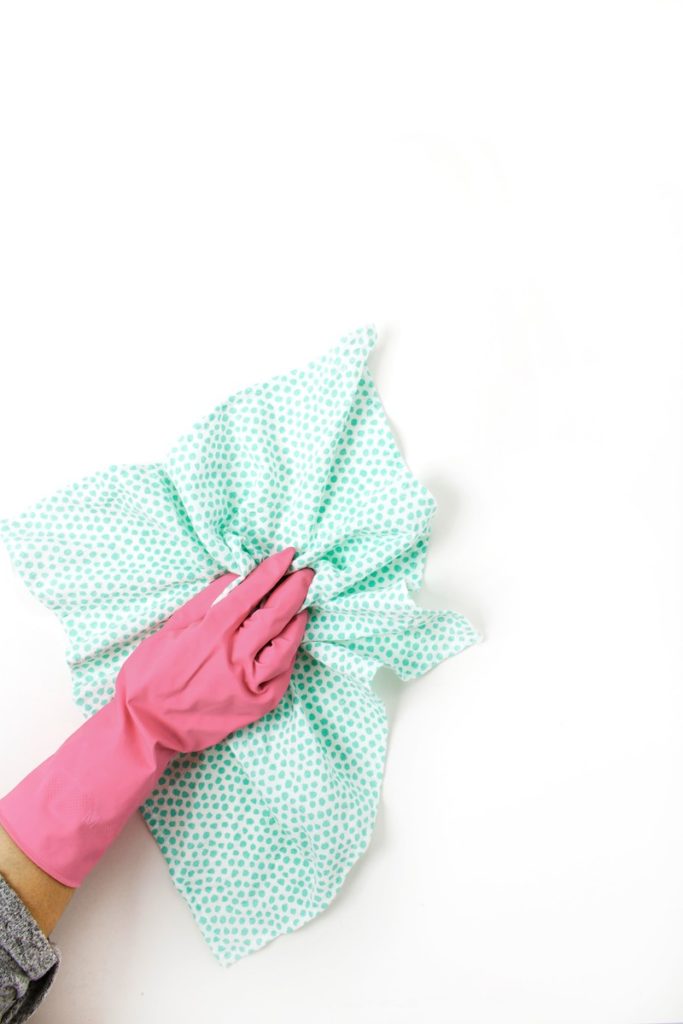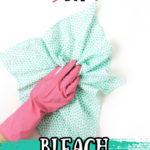DIY Bleach Cleaning Spray
Learn how to make a Bleach Cleaning spray using bleach, water and laundry detergent.

Updated 3/17/2020 to reflectthe Center of Disease Control’s recommendation of a 1:32 bleach dilution ratio
Saying I go through a lot of Clorox Clean Up, or similar bleach cleaners is an understatement. I have old white counter tops and a lot of them! Lately, I have been using Wegman’s Bleach Cleaner, and I am pretty happy with it. During my latest spring cleaning session, I totally ran out, not cool considering I use this stuff everywhere and not just on my counters. I thought maybe I had a pin on Pinterest for a DIY Bleach Cleaner, this was the perfect opportunity to try it out. After scrolling through my Pinterest feed for about 30 minutes I remembered why I was on Pinterest and found the pin for DIY Clorox Clean Up .
I had all the ingredients for my DIY bleach cleaner, and it mixed up fast! I was instantly using it on my counter tops, and it worked well, even on the coffee ring, left from my morning cup of coffee. I have not personally done the math on this, but if I had to guess, I think this would come in at under .05¢ a bottle to make.
If you are looking for a simple and effective disinfectant made with bleach without additional cleaners check out How to Make Your Own Disinfectant Spray with Bleach. It’s a simple and effective bleach solution recommended by the Center for Disease Control.
WHAT KIND OF BLEACH SHOULD I USE FOR HOMEMADE Bleach Cleaning SPRAY
The best kind of bleach to use for homemade disinfectant spray is regular unscented 5%—6% household bleach
Scented bleach versions are not registered disinfectants because they have less of the active ingredient, sodium hypochlorite. A quick scan of Clorox’s labels show that The scented bleaches contain a sodium hypochlorite concentration of 2.75%. The Regular unscented version of Clorox Bleach has a sodium hypochlorite concentration of 6%.
HOW LONG IS HOMEMADE DISINFECTANT SPRAY MADE WITH BLEACH GOOD EFFECTIVE?
Plan on using your Homemade Disinfectant Spray with bleach within 24 hours.
According to Clorox, undiluted household bleach has a shelf life of six months to one year from the date of manufacture. A diluted bleach solution has a shelf life of 24 hours. After 24 hours the sodium hypochlorite begins to break down and the solution loses efficacy.
WHAT SURFACES SHOULD YOU NOT DISINFECTANT WITH BLEACH?
Before you start using homemade disinfectant spray with bleach, it’s important to know that bleach is caustic and can damage some surfaces. That’s also why it’s important to dilute your bleach and ensure that it’s not used at full-strength. Bleach and bleach solutions are not effective on wooden surfaces, it is too porous for bleach to effectively kill germs and bacteria. Bleach also shouldn’t be used on most metals, like stainless steel, as it can damage the finish, and granite which can also be damaged by bleach.
CAN I ADD ESSENTIALS OILS TO HOMEMADE DISINFECTANT SPRAY MADE WITH BLEACH
Mixing essentials oils into your Homemade Disinfectant spray with bleach is not recommended, the effects of mixing bleach with essential oils are not well-known. Some essential oils like lemon, grapefruit and lime are acidic and could potentially create chlorine gas. Enjoy the scent of your essential oils by diffusing them after you have finished cleaning.
PRODUCTS THAT ARE NEVER SAFE TO MIX OR USE WITH BLEACH
It is also important to mention you should never mix common household chemicals with homemade cleaning products. They may react to produce toxic or deadly compounds. Before doing any mixing, always read the product labels first.
- Ammonia -Never combine ammonia-based cleaners with chlorine bleach or products containing bleach, such as powdered dishwasher detergent. The fumes they’ll create are extremely dangerous.
- Vinegar– Bleach and Vinegar produce dangerous chlorine gas which is an irritant to the respiratory system.
- Rubbing alcohol– Combined they create chloroform, which can knock you out, and if you breathe in too much it can be deadly.
- Lemon Juice- Never mix bleach with lemon juice or anything acidic because the combination creates toxic chlorine gas.

DIY Bleach Cleaning Spray
Learn how to make a bleach cleaning spray with bleach, water and laundry detergent.
Materials
- 2 tablespoons bleach
- 1 Teaspoon of Laundry Detergent
- 4 cups of Water
Tools
- Empty 1 quart Plastic Spray Bottle
- 1 small funnel (helpful but not necessary)
Instructions
- Rinse out the plastic spray bottle, add the bleach and laundry detergent. This is where the funnel is helpful!
- Fill the remainder of the bottle with tap water. Shake to mix.
- Now your are ready to start cleaning!
Notes
There are a few recipes floating around for similar bleach cleaners. One calls for liquid dish detergent to be mixed in instead of laundry detergent. The only detergent that comes to mind that would be safe for this cleaner is Dawn Non Ultra Original Scent Dishwashing Liquid as most of the dish detergents now have ammonia in them. Ammonia mixed with bleach creates highly toxic fumes. I opted to avoid the dish detergent all together. Please read your labels if it has ammonia in it the label will say “Do not mix with bleach”








I just read through the question and answer section and saw that this solution should be used within 24 hours or it loses its effectiveness. That seems crazy to me. You are effectively creating the same solution that is used commercially as a shower cleaner and I see no such limitations on those products. I guess I’m going to ignore that portion and give this a try just to save myself a trip to the grocery store.
If the commercial bathroom cleaners are a diluted cloroxn base, how do they not deteriate over time?
Lemon oil is ph neutral- I would guess that so are lime and grapefruit oils.
Every other page says to add Vinegar, which seemed odd to me. Sure enough, you clarified not to use Vinegar. Thanks for that!
Could you use Oils such as the ones you burn above a candle, or would that cause some sort of issue?
My ex almost died from mixing bleach and ammonia, the fumes knocked him out in the shower. Needless to say, I was at work.
What size spray bottle is this for? I am using a 12oz and am not sure if 1/4 c bleach for only 12 oz water is too much?
Hi Lauren,
Yes, please do reduce the amount of bleach!
My cleaner was mixed with about a quart of water which is 32 ounces, so yes, you are going to want to scale back the bleach to just under 1/8 of a cup or 2 tablespoons. I am going to update my post so modifications are easier, but a good rule of thumb for a disinfectant bleach mixture is one (1) Tablespoon of Bleach to one (1) cup of Water.
Hope this helps!
Can u add lemon juice for scent
No, do not mix any other cleaning agents in with bleach, and always be careful not to mix it with acidic cleaners like lemon, ammonia, or vinegar, because it will release toxic chlorine gas.
Could I add a little lemon juice to this for some added scent and cleaning power? And could I use my oxyclean powder instead of laundry detergent?
Do not mix any other cleaning agents in with bleach, and always be careful not to mix it with acidic cleaners like lemon, ammonia, or vinegar, because it will release toxic chlorine gas… as far as a mixing it with Oxyclean which has a peroxide base the two will most likely react, if the mixture is in a closed container the reaction may lead to injury from explosive breakage of the container and dispersible of the contents, and the unintended exposure to the compound.
Is this a no rinse formula, just like Clorox?
did you find out if it was a no-rinse???? its still crazy to me that there is so many CLEANERS that say you need to then USE WATER/Rinse after CLEANING with there product. ITS LIKE YOUR CLEANING twice as much.
I prefer the one step method ?
If you would like a no rinse formula I would simply omit the detergent, so there is no possibility of a soapy residue left behind after you use it.
I made the mistake of mixing dish-soap with bleach to clean my floors.
I did get a headache, and my eyes were stinging a little and I also got a slight dry throat but I just thought it was the bleach fumes causing that.
But after researching what was in my dish-soap (it didn’t have it on the bottle so I had to go online) it did contain alcohols (ethanol and isopropanol) which can make chloroform gas and amines.
So lesson learned.
They really oughta label the full ingredients list on the bottle (and put in bigger letters, perhaps on the front “do not mix with bleach”)
Thanks for the tip-sure enough my dish soap says don’t mix with bleach! I would have never noticed!
You are welcome! The print is so tiny on the bottles it is easy to miss!
Seventh Generation and Mrs. Mayer’s also is ammonia free.
Thank you so much for mentioning the part about not mixing bleach and ammonia!!!!! I was just about to mix up my solution with lemon dish soap!!!!!! You saved the day with your information!!!!
I love this idea! Why spend so much on the store products when I can make my own with what I already have on hand? Thanks!
Thank you for this! I have turned away most commercial cleaners and prefer to make my own! This is going to my to do list for sure!
Thank you Tanya!